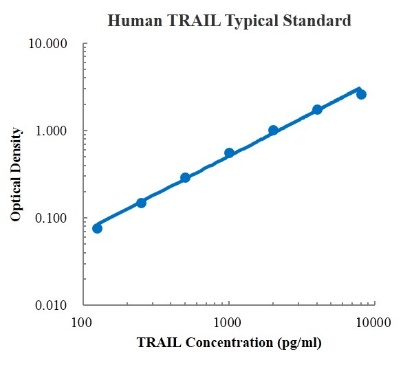
Human TRAIL/TNFSF10 ELISA Kit
$350.00 – $450.00
| Sample Type | Serum, plasma, cell culture supernatant, and other biological samples |
|---|---|
| Sample Volume | 20 μL |
| Sensitivity | 8.19 pg/mL |
| Range | 125 pg/mL – 8000 pg/mL |
| Assay Time | 3.5 h |
| Recovery | 77% – 120% |
| Average Recovery | 0.97 |
| Intra Precision | 6.6% – 8.3% |
| Inter-Precision | 4.8% – 6.4% |
| Platform | ELISA |
| Plate | Detachable 96-well plate |
| Size | 96T/48T |
| Storage | If the reagent kit is unopened, it should be stored at 4℃. However, if it has been opened, the standard solution should be stored at -20℃, while the other components should be stored at 4℃. |
| Delivery | 4℃ blue ice transportation |
| Components | 96-well polystyrene enzyme-linked immunosorbent assay (ELISA) plate coated with anti-TRAIL/TNFSF10 monoclonal antibody Human TRAIL/TNFSF10 freeze-dried standard TRAIL/TNFSF10 detect Antibody Standard Diluent Assay Buffer(10×) Substrate TMB Stop Solution Washing Buffer(20×) Sealing Film |
| Assay Principle | This kit utilizes the double antibody sandwich enzyme-linked immunosorbent assay (ELISA) detection technique.Specific anti-human TRAIL antibodies are precoated on a high-affinity ELISA plate.Standards and test samples are added to the wells of the ELISA plate. After incubation, the TRAIL present in the samples binds to the solid-phase antibodies. After washing to remove unbound substances, biotinylated detection antibodies are added and incubated. After washing to remove unbound biotinylated antibodies, streptavidin-HRP labeled with horseradish peroxidase is added. After washing, a colorimetric substrate, TMB, is added and the plate is incubated in the dark for color development. The intensity of the color reaction is directly proportional to the concentration of TRAIL in the samples.A stop solution is added to terminate the reaction, and the absorbance value is measured at a wavelength of 450 nm (with a reference wavelength range of 570-630 nm). |

Targets
TNFSF10
TNFSF10 Target Infomation Overview
- Target Symbol: TNFSF10, TNF superfamily member 10
- Gene Groups: CD molecules; Tumor necrosis factor superfamily
- Alias: TRAIL; Apo-2L; TL2; CD253
- Alias Names: tumor necrosis factor (ligand) superfamily, member 10
TNFSF10, TNF superfamily member 10 Target Infomation by Species
Human TNFSF10 Target Information
- Target Symbol: TNFSF10, TNF superfamily member 10
- Alias:
- Apo-2 ligand
- Apo-2L
- APO2L
- CD253
- chemokine tumor necrosis factor ligand superfamily member 10
- TL2
- TNF-related apoptosis inducing ligand TRAIL
- TNF-related apoptosis-inducing ligand
- TNLG6A
- TRAIL
- tumor necrosis factor (ligand) family, member 10
- tumor necrosis factor (ligand) superfamily member 10
- tumor necrosis factor (ligand) superfamily, member 10
- tumor necrosis factor apoptosis-inducing ligand splice variant delta
- tumor necrosis factor ligand 6A
- tumor necrosis factor ligand superfamily member 10
- tumor necrosis factor superfamily member 10
- NCBI_Gene: 8743
- UniProtKB: P50591
Human TNFSF10 Predicted Functions
Enables identical protein binding activity and zinc ion binding activity. Involved in positive regulation of cysteine-type endopeptidase activity involved in apoptotic process; positive regulation of release of cytochrome c from mitochondria; and positive regulation of signal transduction. Located in extracellular exosome. Implicated in arteriosclerosis and small cell carcinoma. Biomarker of type 1 diabetes mellitus.
Mouse Tnfsf10 Target Information
- Target Symbol: Tnfsf10, tumor necrosis factor (ligand) superfamily, member 10
- Alias:
- A330042I21Rik
- AI448571
- APO-2L
- expressed sequence AI448571
- RIKEN cDNA A330042I21 gene
- TNF-related apoptosis inducing ligand
- Trail
- NCBI_Gene: 22035
Mouse Tnfsf10 Predicted Functions
Enables TRAIL binding activity and tumor necrosis factor receptor superfamily binding activity. Acts upstream of or within positive regulation of extrinsic apoptotic signaling pathway. Predicted to be located in extracellular space and plasma membrane. Predicted to be integral component of membrane. Is expressed in central nervous system; genitourinary system; gut; and retina. Human ortholog(s) of this gene implicated in arteriosclerosis and small cell carcinoma. Orthologous to human TNFSF10 (TNF superfamily member 10).
Rat Tnfsf10 Target Information
- Target Symbol: Tnfsf10, TNF superfamily member 10
- Alias:
- 4-1BB
- LOC500590
- MGC114552
- similar to T-cell antigen 4-1BB precursor – mouse
- tumor necrosis factor receptor superfamily member 9
- tumor necrosis factor receptor superfamily, member 9
- NCBI_Gene: 246775
- UniProtKB: E9PU84
Rat Tnfsf10 Predicted Functions
Predicted to enable cytokine binding activity; identical protein binding activity; and signaling receptor activity. Predicted to be involved in regulation of cell population proliferation. Predicted to act upstream of or within negative regulation of interleukin-10 production and negative regulation of interleukin-12 production. Predicted to be located in extracellular space and plasma membrane. Predicted to be active in external side of plasma membrane. Orthologous to human TNFRSF9 (TNF receptor superfamily member 9).



